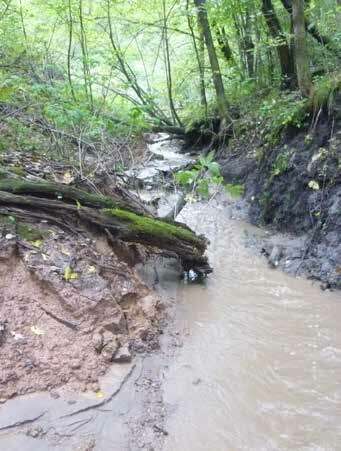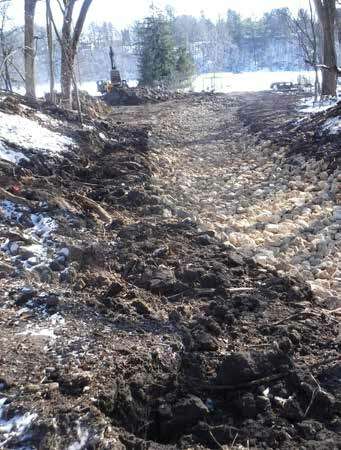When Janet Christianson moved to Elk Creek Lake, she was instantly taken with the calm and scenic shores of the 57-acre body of water. The man-made lake sits between Dunn and Eau Claire counties, making its cold waters a favorite local spot for paddle sports, boating, fishing, and swimming. However, Christianson eventually noticed that the lake faced a pressing issue.
Severe runoff—especially after intense rainfalls or snowmelt—would flood the public boat access and park, wash away the lake’s beach, cover the parking areas in muck, and carry unwanted sediment into the lake. She decided to attend a meeting of the Elk Creek Lake Protection and Rehabilitation District to learn more about these issues, which were mostly stemming from a nearby ravine. Soon after, she found herself nominated as the Lake District’s new secretary and, with the encouragement of the local township, embarked on a mission to better understand the issues and challenges of finding a lasting solution.
Christianson was not the first person to recognize this problem. The Lake District, Spring Book Town Board, and local citizens had a long history of concerns with the severely eroding ravine. The land’s drainage area that flows into the ravine covers 294 acres and consists mostly of continuous row cropped farmland, with some wooded residential areas. A significant portion of this cropland is tile-drained and the discharge from these drain systems hinders the establishment of vegetation on the steep downstream channel and slopes. The ravine’s soils consist of layers of dense silt and clay sandwiched between layers of sand, creating a barrier that restricts the vertical flow of groundwater and instead directs it horizontally, causing it to seep out at the sides and bottom of the ravine.
The major challenge in finding a long-term solution quickly became evident: funding. Bob Kaner, a conservation planner working in the Dunn County Land & Water Conservation Department, explained that their office had been receiving requests for assistance in stabilizing the eroding ravine since 2013. However, the township and property owners were unable to afford the cost of the project. In 2014, the estimated cost was approximately $65,000, and since then, the current estimate had risen to nearly $100,000. Meanwhile, the erosion and runoff continued to impose costs on the township, as the lake required dredging, sediment removal by trucks, and frequent road repairs.
Christianson and Kaner knew they had to find a significant source of funding. “I’d always had a great interest in conservation and taking care of the earth,” Christianson said. “I was nearing retirement, and there was something I’d always wanted to do—write a grant.” So, when the application for DNR’s Surface Water Restoration Grant opened, Christianson and Kaner developed a proposal and plan that would properly address the runoff.
Kaner and a local contractor, Brent Wachsmuth, collaborated on ideas to widen the bottom of the ravine from four to 14 feet. Their goal was to create an access road that would not only accommodate the installation of the lined rock way but also allow for future light maintenance access. Kaner drew up a plan that included the installation of a rock-lined waterway that was designed to safely contain the flows of a 10-year storm within its channel.
“One of the biggest challenges was that we needed to line 600 feet of the 25-foot deep, narrow ravine with riprap rock placed over geotextile fabric” said Kaner. Winter construction would be used with the hopeful idea of clearing and shaping the wet ravine, then subgrade could be used to form a frozen access road for hauling materials deep into the ravine. “I had been thinking about this project for a long time, so I was thankful that Chase Cummings, our LWCD department head, trusted me to work on this,” Kaner said. He then worked with Pete Wurzer, DATCP Conservation Engineer, to refine and finalize the plans.
Fortunately, they were awarded the $50,000 DNR grant, but increased construction costs meant that they still needed to raise nearly $50,000 to complete the project.
To help meet the funding goal, funds were contributed by the Town of Spring Brook, the Town of Union, Dunn County, and Eau Claire County.
Kaner and Christianson then worked to get landowner access agreements created and recorded. Much of their work included educating lakeshore property owners on the importance of finding a solution. “There were multiple landowners who needed to be involved, and a major construction project can be daunting,” said Kaner. “It’s important to take the time to explain what’s going on their land, and once they understand, they have a much greater buy-in for the project.”
Christianson began soliciting donations from various sources with a connection to the lake, ranging from individual homeowners to Doane Kidney Bean Company, among others. In addition, the Lake District and landowners hosted a neighborhood potluck fundraiser, where they explained the plans and the positive impact that it would have on the lake. With the funding gap finally closed, work could finally begin on the ravine.
Kaner’s involvement didn’t stop at the planning stages. He, along with other staff from their department, hauled rocks and staked and measured slopes during project construction. “Brent and I watched the weather and when the forecast showed perfect temps with highs of 2° and lows of -20°,” Brent entered the ravine from the outlet end,” explained Kaner.“ He worked upstream clearing and shaping the bottom and sides, and then left the site for a day to freeze down.” The contractor would build about eight to 10 feet of the lined waterway at a time, and then move downstream and build another eight to 10 feet.
“We had quite a spectator group when the project started in January,” said Kaner. “They were excited to see something finally happening and engaged community members are what kept this project going.” After two weeks of winter construction and a decade of concern, the ravine’s remodel was complete.
In July of the following summer, the lined waterway was extended 200 feet downstream to new road culverts. This reach was funded by the Town of Spring Brook, the Lake District, and donations by the contractor.
“I could not believe the amount of time and effort that Bob put into this,” said Christianson. “He was out here checking on things during the project, and had been thinking about it for years before. And he was educating me all along the way,” she added.
Since the project’s completion, both Christianson and Kaner have noticed improvements. After a recent rain, Christianson noticed that the water running through the culvert into the lake was crystal clear, and she’s also started to see more loons and frog eggs around the lake.
For Kaner, a crucial next step is working with the farmland owners.


Originally featured in DATCP 2022 Wisconsin Report on Soil and Water Conservation
